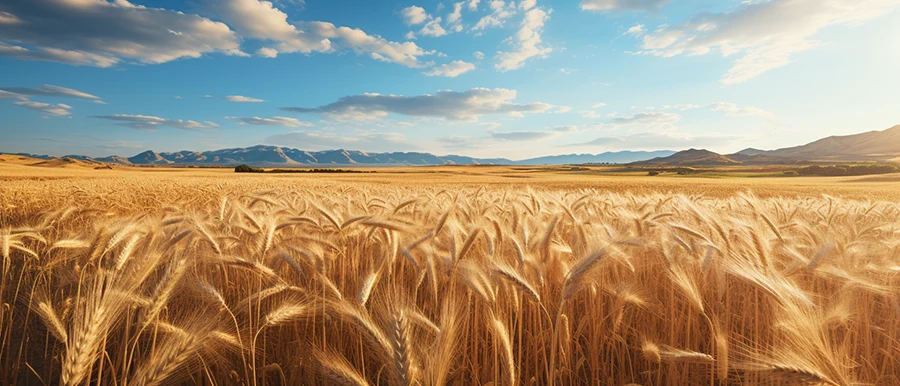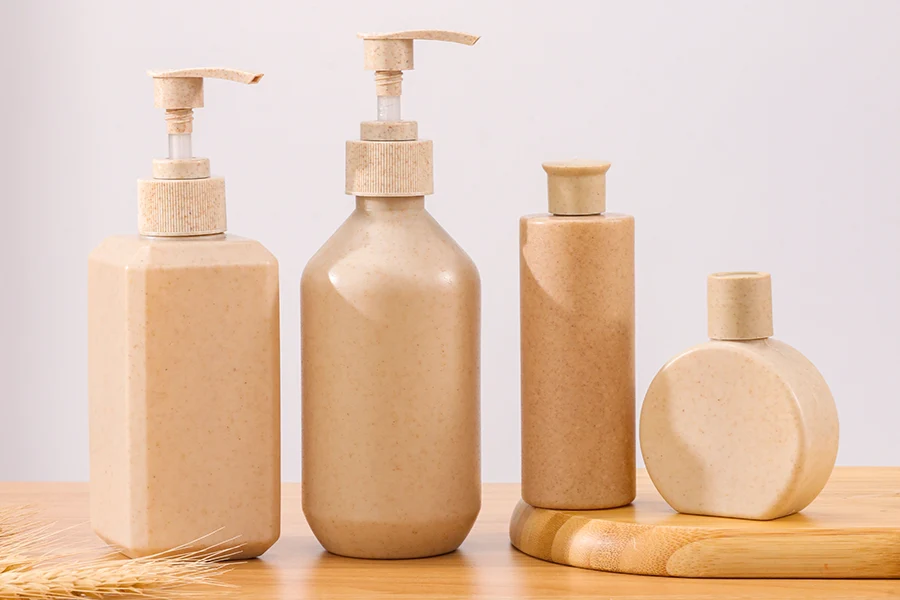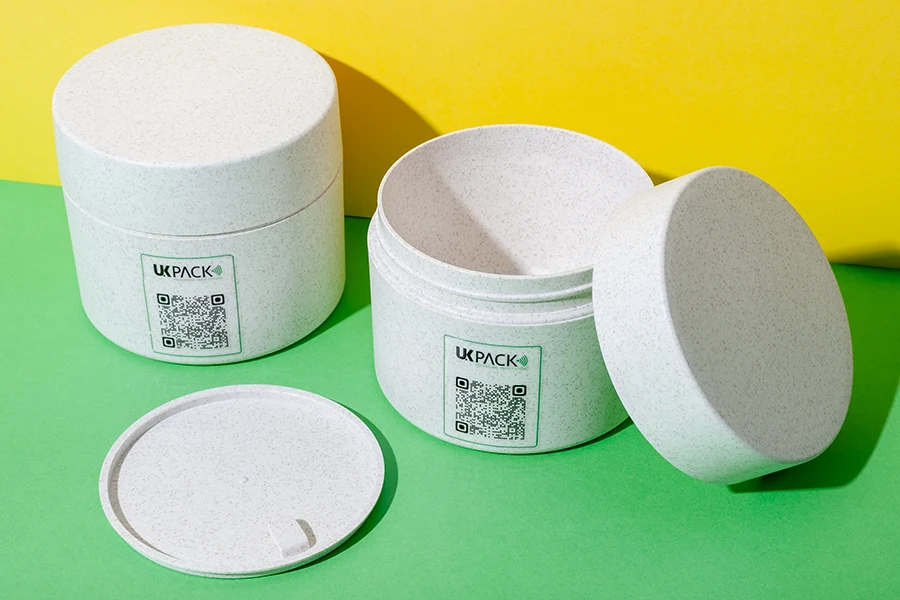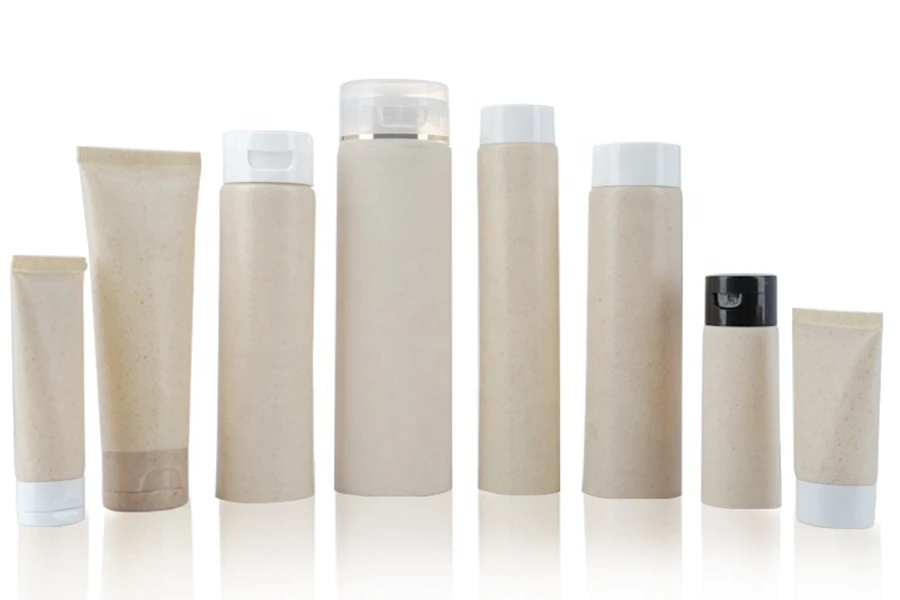A quick overview of the topics covered in this article.
Subscribe to the UKPACK newsletter to receive regular updates on the company, products, services, upcoming exhibitions and more.
As a professional cosmetic packaging company deeply entrenched in the pursuit of eco-innovation, UKPACK strides at the forefront of sustainable cosmetic packaging. With a discerning eye on the future, we are delving into the transformative realm of wheat straw plastic, a material that is beginning to redefine the very fabric of consumer products. Could this be the eco-alternative that turns the tide? We invite you to journey with us and unearth the depths of wheat straw plastic’s potential.
What is Wheat Straw Plastic?

Crafted from the cellulose found in the stalks of wheat plants after the grain harvest, wheat straw plastic converts potential agricultural waste into a valuable and sustainable resource. This bioplastic, unlike traditional plastics made from petrochemicals, leverages the natural polymers inherent to plant materials, creating a more eco-conscious alternative.
The process that turns wheat straw into a plastic-like substance involves polymerization, granting the end product comparable durability and adaptability to conventional synthetic plastics. Furthermore, lignin, a natural compound that maintains the rigidity of wheat stalks, enhances the strength of this bioplastic, making it a robust and versatile material.
Wheat straw plastic excels within the realm of eco-friendly materials due to its renewable origins and biodegradability, tackling head-on the significant environmental issues of pollution and waste linked to fossil fuel-based plastics. As it is BPA-free and adheres to food-grade standards, it has garnered FDA approval, reinforcing its stature as a safe alternative for everyday use.
It is uniquely positioned in the market as a lightweight yet strong material, ideal for a spectrum of products from disposable items such as plates and cutlery to more permanent solutions. In addition, it defies expectations by being gluten-free, despite being derived from wheat, thus catering to a wide range of consumers, including those with gluten sensitivities.
With its certification for food safety and absence of BPA, wheat straw plastic epitomizes the advancements in material innovation. It showcases the transformative potential of agricultural byproducts, paving the way for the creation of consumer goods that not only serve practical purposes but also contribute positively to environmental sustainability.
How is Wheat Straw Plastic Made?
The production of wheat straw plastic is a testament to the innovative use of agricultural byproducts, transforming wheat straw, otherwise considered waste, into a sustainable material. The process involves several key steps:
- Collection and Preparation of Wheat Straw: After the wheat harvest, the leftover stalks are gathered. These stalks, rich in cellulose, serve as the raw material for wheat straw plastic.
- Pulverization: The collected wheat straw is then pulverized into smaller pieces. This increases the surface area, making the cellulose more accessible for the subsequent chemical processes.
- Chemical Treatment: The pulverized straw undergoes a chemical treatment to extract cellulose and remove lignin and other substances. This step is crucial for isolating the cellulose, which is the primary component needed to form the plastic.
- Polymerization: The extracted cellulose is then subjected to a polymerization process. During this phase, the cellulose molecules bond together, forming long chains that are characteristic of plastic materials. This process endows wheat straw plastic with its strength and flexibility.
- Molding and Shaping: Once the polymerization is complete, the resulting material is melted and can be molded into various shapes and forms, depending on the intended use. From disposable cutlery to packaging materials, wheat straw plastic can be engineered to meet a wide range of needs.
- Cooling and Solidifying: The molded items are then cooled and solidified, retaining their shape as they harden. This final step ensures the stability and durability of the wheat straw plastic products.
This entire process highlights the transformative potential of utilizing wheat straw, an agricultural byproduct, to create a biodegradable and eco-friendly alternative to traditional plastics. Through innovative chemical engineering and strategic manufacturing processes, wheat straw plastic is paving the way for more sustainable material solutions.
Is Wheat Straw Plastic Safe?
Absolutely, wheat straw plastic is recognized for its safety and durability, making it an excellent choice for everyday use. Notably, it is both microwave and freezer safe, which underscores its versatility and resilience. This bioplastic undergoes rigorous testing to ensure it meets strict health and safety standards before it reaches the consumer.
Microwave Safety: Wheat straw plastic is designed to withstand the heat generated by microwaves, making it a convenient option for reheating food. Unlike some plastics that can release harmful chemicals when heated, wheat straw plastic maintains its structural integrity and does not leach chemicals into the food, ensuring that your meals are safe to consume.
Freezer Safety: Similarly, this material’s robust composition allows it to endure the extreme cold of freezers without becoming brittle or degrading over time. This makes wheat straw plastic containers an ideal choice for food storage, as they can go directly from freezer to microwave, simplifying meal prep and reducing the need for multiple containers.
BPA-Free and FDA-Approved: Ensuring consumer safety, wheat straw plastic is BPA-free. Bisphenol A (BPA) is a chemical commonly found in plastics that has raised health concerns. By eliminating BPA from its composition, wheat straw plastic offers a safer alternative for food and beverage containers. Furthermore, it has been approved by the FDA, affirming its safety for contact with food.
Is wheat straw plastic biodegradable?
Yes, wheat straw plastic is renowned for its biodegradable properties, offering a sustainable alternative to conventional plastics. Its capacity to decompose through various methods marks a significant step towards reducing plastic waste and its environmental impact.
Composting Options: Wheat straw plastic can be composted, turning it back into soil over time. While some wheat straw products are suitable for home composting, breaking down within a household compost pile, others may require the conditions of industrial composting facilities to fully decompose. This versatility in composting options makes wheat straw plastic a flexible choice for disposal, catering to the capabilities and resources of different communities.
Decomposition in Landfills: In scenarios where composting isn’t an option, wheat straw plastic is still designed to biodegrade in landfills more effectively than traditional plastics. Although the decomposition rate can vary based on environmental conditions, the presence of wheat straw plastic in landfills contributes less to long-term pollution and is a step towards a more sustainable waste management system.
Certification and Recognition: For a bioplastic to be officially recognized as biodegradable, it must meet specific standards, such as those outlined in the EN13432 certification. This certification ensures that a product can decompose under the conditions of industrial composting facilities, turning into carbon dioxide, water, and biomass within a certain timeframe. Consumers looking for genuinely biodegradable products should check for this certification or similar endorsements.
Recycling and Repurposing: Beyond biodegradation, some wheat straw plastics are also recyclable. They can be processed through local recycling programs, where they are sorted, cleaned, and repurposed into new products. This recycling pathway further extends the life of the material, reducing the need for virgin resources and encouraging a circular economy where materials are continually reused.
Comparing Wheat Straw Plastic and Traditional Plastics
The comparison between wheat straw plastic and traditional plastics highlights significant differences in terms of environmental impact, sustainability, and lifespan among other aspects. Let’s delve deeper into these differences:
1. Environmental Impact
Wheat Straw Plastic: Being derived from a renewable resource (wheat straw), its production has a smaller environmental footprint. The process of making wheat straw plastic consumes less energy and resources, and due to its biodegradability, its eventual impact on the environment is also lower.
Traditional Plastic: Traditionally made from petroleum, a non-renewable resource, its production not only consumes a substantial amount of energy but also generates a significant amount of greenhouse gases. Additionally, they are generally non-biodegradable, taking hundreds of years to decompose in the natural environment, causing long-term ecological impacts.
2. Sustainability
Wheat Straw Plastic: Originating from agricultural by-products and can be processed through biodegradation or recycling, it reduces long-term environmental pollution. This “from land to land” cycle of use theoretically represents a more sustainable option.
Traditional Plastic: Given its reliance on petroleum, a finite resource, coupled with its low recycling rate and poor biodegradability, traditional plastics have a greater negative environmental impact at the end of their life cycle, making them less sustainable.
3. Lifespan and Functionality
Wheat Straw Plastic: Although it may not match traditional plastics in durability and strength in certain applications, for single-use or short-term use products, wheat straw plastic offers a practical and environmentally friendly choice.
Traditional Plastic: Due to its excellent durability and versatile chemical properties, traditional plastic has a wide range of applications. However, this durability is also why it is difficult to degrade in the environment.
4. Cost and Economics
Wheat Straw Plastic: Initial investment might be higher due to the need for establishing production technology and recycling systems. However, as the technology matures and scales up, costs are expected to decrease.
Traditional Plastic: Due to mature production technology and economies of scale, its production cost is relatively lower. However, when considering potential costs for environmental cleanup and health impacts, the true cost may be much higher.
Application of Wheat Straw Plastic in Cosmetic Packaging
The cosmetics industry, known for its emphasis on aesthetics and sustainability, has been exploring eco-friendly packaging solutions to align with the increasing consumer demand for sustainable products. Wheat straw plastic, with its biodegradable and sustainable characteristics, presents a promising alternative for cosmetic packaging. Below are some of the innovative applications of wheat straw plastic:
1. Wheat Straw Bottles

These bottles are used for liquid cosmetics such as shampoos, conditioners, and lotions. The main advantages include reduced carbon footprint during production and the ability to biodegrade, which significantly lowers their environmental impact compared to traditional plastic bottles.
2. Wheat Straw Jars

Ideal for packaging creams, gels, and powders, wheat straw jars offer a sustainable packaging option that doesn’t compromise on quality or functionality. Their sturdy nature ensures product safety, while their biodegradability contributes to environmental conservation.
3. Wheat Straw Tubes

Used for items like lip balms, hand creams, and mascaras, these tubes provide a sustainable yet functional packaging solution. They combine the convenience of traditional plastic tubes with the environmental benefits of wheat straw plastic, making them a preferred choice for both brands and consumers aiming for sustainability.
Market Trends for Wheat Straw Plastic Packaging
1. Consumer Preferences for Sustainable Packaging
Recent years have seen a significant shift in consumer behavior, with a growing number of shoppers expressing a preference for products with eco-friendly packaging. Surveys and market research indicate that consumers are willing to pay a premium for sustainability, which includes packaging made from materials like wheat straw plastic. This shift is driven by increased environmental awareness and concern for the planet’s future.
2. Market Growth Forecast and Analysis
The market for wheat straw plastic packaging is projected to experience substantial growth in the coming years. Analysts predict an upward trajectory, driven by the combination of regulatory pressures to reduce single-use plastics, technological advancements in bioplastics, and the escalating demand for sustainable packaging solutions from both consumers and businesses. The analysis suggests that as production costs decrease with advancements and scale, wheat straw plastic could become a more accessible option for a wider range of companies, further propelling its market growth.
Challenges and Opportunities of Wheat Straw Plastic
The rising interest in wheat straw plastic as a sustainable packaging material brings with it a set of challenges and opportunities.
1. Technical and Cost Challenges
Technical Limitations: One of the primary challenges involves the technical limitations of wheat straw plastic, including concerns related to its durability, versatility, and performance compared to conventional plastics. Research and development efforts are crucial to improve its physical properties and functionality for broader applications.
Cost Implications: The production of wheat straw plastic currently faces cost barriers, primarily due to the relatively high expenses involved in processing and manufacturing. Economies of scale have yet to be achieved, making wheat straw plastic more expensive than traditional packaging materials, which can limit its widespread adoption.
2. Regulatory and Certification Issues
Regulatory Hurdles: The adoption of wheat straw plastic is also hampered by regulatory hurdles. Different regions have varying standards and regulations for biodegradable and compostable materials, making it challenging for manufacturers to comply and market their products globally.
Certification Processes: Obtaining certifications that validate the environmental benefits of wheat straw plastic can be a lengthy and costly process. Certifications are critical for market acceptance, but the complexity and cost associated with these processes can deter smaller manufacturers or startups.
3. Pathway from Challenges to Opportunities
Innovation in Material Science: The pathway from challenges to opportunities lies in continued innovation within material science. Advancements in technology can improve the properties of wheat straw plastic, making it a more competitive and appealing option for a wide range of applications.
Scaling Production: By scaling production and achieving economies of scale, the cost of wheat straw plastic can be reduced, making it a more financially viable option for companies looking to adopt sustainable packaging solutions.
Collaborative Efforts: Collaboration between governments, research institutions, and industries can help navigate regulatory challenges and streamline certification processes. Joint efforts can also spur innovation, reduce costs, and promote the adoption of wheat straw plastic on a larger scale.
Educating Stakeholders: Educating consumers, manufacturers, and regulators about the benefits and potential of wheat straw plastic is crucial for its adoption. Increased awareness can drive demand, encourage regulatory support, and foster a market environment conducive to sustainable packaging solutions.
Strategies for Implementing Wheat Straw Plastic Solutions
Implementing wheat straw plastic solutions requires strategic planning and execution across various aspects of the business and production processes. The following strategies can help ensure a smooth transition toward adopting wheat straw plastic in manufacturing and packaging, maximizing both environmental and economic benefits.
1. Supply Chain Integration
Sourcing and Partnerships: Establishing strong relationships with suppliers of wheat straw and manufacturers of wheat straw plastic is crucial. Sourcing sustainably produced wheat straw ensures the environmental integrity of the supply chain.
Streamlining Logistics: Integrating wheat straw plastic into the production process may require adjustments in logistics and supply chain management. Efficient logistics can reduce costs and environmental impact associated with transportation and storage.
Quality Control: Implementing rigorous quality control measures throughout the supply chain ensures that the wheat straw plastic meets required standards and specifications for its intended use, maintaining product integrity and consumer trust.
2. Collaboration with Stakeholders
Industry Partnerships: Collaborating with other companies and industry groups can help share knowledge, reduce costs, and co-create market standards for wheat straw plastic. Joint initiatives can also enhance innovation and market acceptance.
Regulatory Engagement: Working closely with regulatory bodies to understand and influence the development of standards and certifications for biodegradable and compostable materials can facilitate market entry and compliance.
Academic and Research Collaboration: Partnering with academic institutions and research organizations can drive innovation in the formulation and production processes of wheat straw plastic, leading to improved material properties and new applications.
3. Educating Consumers and Customers
Awareness Campaigns: Conducting awareness campaigns to educate consumers and businesses about the benefits of wheat straw plastic, including its environmental advantages, can stimulate demand and encourage adoption.
Transparent Communication: Providing clear, transparent information about the sustainability credentials, performance, and lifecycle of wheat straw plastic products can build trust and support from consumers and clients.
Engagement and Feedback: Engaging with consumers and clients to gather feedback on wheat straw plastic products can inform improvements and highlight areas for innovation. Listening to the market can help tailor products to meet evolving needs and preferences.
Conclusion
As the global community increasingly prioritizes sustainability, the adoption of wheat straw plastic in the beauty industry represents a significant step towards environmentally responsible practices. Wheat straw plastic offers a promising solution by reducing reliance on fossil fuel-based materials, minimizing waste, and supporting the circular economy. However, the transition to these sustainable packaging solutions involves navigating technical, regulatory, and market challenges. Success in this endeavor requires collaborative efforts, innovation, and a commitment to educating both the supply chain and the end consumers about the benefits and importance of sustainable packaging options.
UKPACK is at the forefront of providing wheat straw packaging solutions tailored for beauty brands. By choosing UKPACK, beauty brands can leverage cutting-edge sustainable packaging technologies that not only meet their product needs but also resonate with the growing consumer demand for eco-friendly products. Our expertise encompasses supply chain integration, ensuring high-quality and sustainable sourcing of materials, and offering comprehensive support from design to delivery. Our collaborative approach with stakeholders ensures that beauty brands can navigate regulatory landscapes smoothly and efficiently.
References
1. Wheat Straw – Source: ResearchGate
2. Unleashing the Power of Wheat Straw – Source: Omland Hospitality
3. A comparative life cycle analysis of wheat straw utilization modes in China – Source: ScienceDirect

Content Manager at UKPACK. I have extensive experience in the packaging industry and specialize in creating engaging content. I’m passionate about staying ahead of industry trends.
How Do Airless Pump Bottles Work?
Airless pump bottles have become a staple in the beauty and skincare industries, offering a unique solution to preserve and dispense products. They provide a sophisticated method of protecting [...]
Ultimate Guide: How To Fill Cosmetic Tubes Effectively
Filling cosmetic tubes effectively is a crucial step in the cosmetic manufacturing process. Whether you’re working with skincare creams, gels, or liquid makeup, the goal is to ensure a [...]
30 Best Korean Skincare Brands You Need to Know
Korean skincare brands have taken the global beauty scene by storm, becoming a staple for skincare enthusiasts worldwide. Renowned for their unique formulations, cutting-edge ingredients, and comprehensive multi-step routines, [...]




